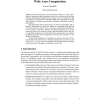Free Online Productivity Tools
i2Speak
i2Symbol
i2OCR
iTex2Img
iWeb2Print
iWeb2Shot
i2Type
iPdf2Split
iPdf2Merge
i2Bopomofo
i2Arabic
i2Style
i2Image
i2PDF
iLatex2Rtf
Sci2ools
98
Voted
ICALP
1999
Springer
1999
Springer
Wide Area Computation
Abstract. The last decades have seen the emergence of the sea of objects paradigm for structuring complex distributed systems on workstations and local area networks. In this approach, applications and system services are composed of and communicate among themselves through reliable and transparently accessible object interfaces, leading to the interaction of hundred or thousands of unstructured objects. This approach has lead to major progress in software composability and reliability. Unfortunately, it is based on a number of assumptions that do not hold on wide area networks. There, access to resources is intrinsically unreliable (because of failure, congestion, voluntary disconnected operation, etc.) and not transparent (because of variations in latency and bandwidth, hardware and software mobility, and the presence of firewalls). These characteristics are so radically different from the current computational norm that they amount to a new model of computation. We discuss the chall...
Related Content
| Added | 04 Aug 2010 |
| Updated | 04 Aug 2010 |
| Type | Conference |
| Year | 1999 |
| Where | ICALP |
| Authors | Luca Cardelli |
Comments (0)

